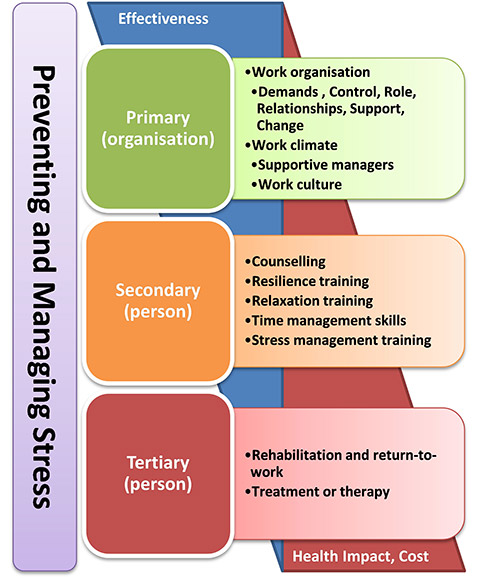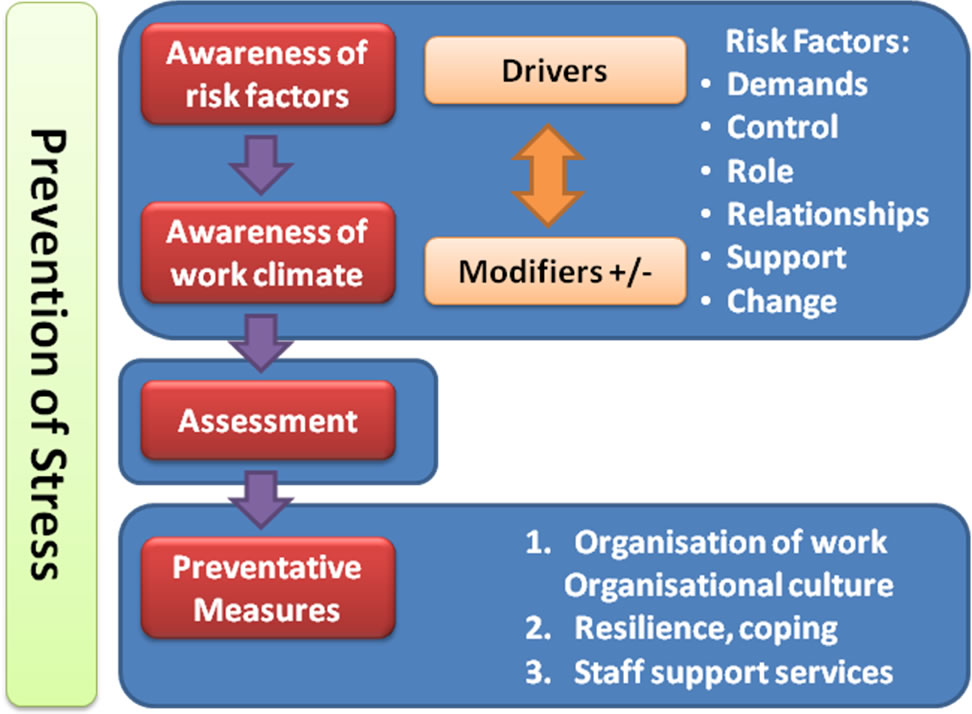Managers role in workplace stress risk management
- Introduction
- Risk management of workplace stress
- Prevention of workplace stress
- What can I do to prevent stress from becoming a problem?
- How can managers deal with workplace stress?
- Tools and resources
Introduction
In Australia, the work of Cotton and Hart distinguishes operational demands and the context in which work is conducted, and recognises that contextual factors (such as leadership and managerial practices, climate and culture) strongly influence how employees cope with and manage their operational demands. Cotton and Hart have found that contextual factors tend to exert a stronger influence on staff wellbeing outcomes when directly compared with a wide range of operational stress risk factors. In particular, their research shows that 'supportive leadership' and a high quality 'work team climate' strongly influence individual morale, which buffers staff against the impact of work-related stress risk factors.
Risk management of workplace stress
Workplace stress is a health and safety issue and comes under the OHS Act. This means the University through its managers and supervisors, is required to prevent and address workplace stress using a risk management framework. In applying a risk management framework it is important to appreciate that both organisational and individual level interventions to address the causes of psychological injury are generally more effective than approaches that solely focus on the staff member.

Staff member-focussed approaches such as counselling, relaxation training, time management skills and stress management training can assist staff to develop greater resilience to work-related stress or help them better deal with personal stressors. Stress management programs teach workers about the nature and sources of stress, the effects of stress on health, and personal skills to reduce stress. This training may rapidly reduce stress symptoms such as anxiety and sleep disturbances; it also has the advantage of being inexpensive and easy to implement. However these approaches do little to address the organisational sources of work-related stress. As such they are less likely to produce sustainable prevention outcomes, address the root causes of stress or result in improvements in organisational performance.
Organisational Stress Management focuses improve working conditions or climate. This approach is the most direct way to reduce stress at work. It involves the identification of stressful aspects of work and the design of strategies to reduce or eliminate the identified stressors. The advantage of this approach is that it deals directly with the root causes of stress at work and produces the best results. However, managers are sometimes uncomfortable with this approach because it can involve changes in work routines or production schedules, or changes in the organisational structure. Approaches developed within a framework for continuous improvement, rather than with an expectation of dramatic and uniformly positive impact, are also recommended.
Prevention of workplace stress
The expectation under the OHS Act is that managers will do everything practicable to prevent injury through workplace stress.
This should occur when a new process or job is introduced. As well as considering the physical hazards such as manual handling or ergonomics, the psychological hazards should be considered.
Work demands are the easiest to identify. Work demand risk factors such as pace of work and work variety are more easily recognised compared to more esoteric support risk factors such as respect and management culture. It may be similarly difficult to see how drivers such as difficult clients are offset positively or negatively by support from managers and other team members.
Nevertheless experienced, competent managers will have an understanding of the work climate interacts with the organisation of the work.
The recommended preventative approach to risk management of stress involves four steps:
- Identifying the sources of potential harm to staff health and wellbeing
- Systematically assessing the risk of staff being harmed
- Developing and implementing actions to:
- address the workplace factors that present a risk of psychological injury
- minimise the impact of stress on staff through supportive management and promoting staff health and wellbeing
- Monitor and review the implementation and effectiveness of the interventions to ensure continuous improvement.
For more information on workplace stressors see risk factors for workplace stress. The job stress identification checklist can be used to evaluate the stress associated with a job. Once the risk factors have been identified the management action checklist can be used to develop control measures.

What can I do to prevent stress from becoming a problem?
Most of the 'things to do' boil down to good supportive management. They're ongoing processes that need to be built into the way your unit is run.
- Show that you take stress seriously, and be understanding towards people who admit to being under too much pressure. Avoid being judgemental or seeking explanations in personality "flaws".
- Encourage your managers to have an open and understanding attitude to what people say to them about the pressures of their work, and to look for signs of stress in their staff.
- Ensure that staff have the skills, training and resources they need, so that they know what to do, are confident that they can do it and receive credit for it.
- If possible, provide some scope for varying working conditions and flexibility, and for people to influence the way their jobs are done. This will increase their interest and sense of ownership.
- Ensure that people are treated fairly and consistently and that poor or inappropriate behaviours (not just bullying and harassment) aren't tolerated.
- Ensure good two-way communication, especially at times of change. Don't be afraid to listen and be honest about your own feelings. However do not "dump" your stress or anxiety on the staff member.
- Understand and be sensitive to the ebb and flow of the workplace in terms of staff movements, workload changes and fluctuating external demands. Plan for these fluctuations in advance.
- Be approachable and available for your staff, and address issues clearly, honestly, in a timely manner and in an objective manner.
Ask yourself whether you do these things. If you don't, or are unsure whether you do, take a look at the suggestions on 'what management can do' in the guide Management Competency Framework: Workplace Stress.
How can managers deal with workplace stress?
The standard OHS risk management methodology of "find, assess and fix" can be applied to workplace stress. The five basic steps are:
| Look | The first step is about paying attention to your staff, noticing any changes in their usual behaviour or relationships. It may be also worthwhile reviewing leave use, both recreation and sick leave as well as over-time or time in lieu. |
| Listen | Listen to what staff are saying: are there more complaints or excuses than unusual? Has the level of conflict or sensitivity increased? How much impact is the stress having? |
| Think | Think about what you have observed and how that relates to the factors that typically lead to workplace stress. Focus on the obvious causes but do not ignore the full range of possibilities. Be honest with yourself: what is my contribution? If you believe the stress is not work related, how is work aggravating the situation? |
| Discuss | If appropriate, discuss the issues with your staff individually and/or as a group. If you need assistance, talk to your Human Resources Partner first |
| Act | Put into place a plan to reduce, offset, rebalance, or better manage the stress. This is preferably done in consultation with staff. |
If you practice management competencies outlined in the Manager Competency Framework, you will have already built up the trust and relationships that will allow you to intervene early and effectively deal with workplace stress.
Management actions that can make a difference include:
- making a simple offer of support and assistance
- flexibly accommodating reasonable adjustments to help the staff member remain at work.
The local manager plays a pivotal role in demonstrating support to the injured worker.
Tools and resources
- Dealing with stress: talking to your staff - A more detailed step by step guide with supporting material
- Job Stress Risk Identification checklist for managers (DOCX, 28.0KB) . The checklist can be used to help identify the causes and contributing factors to workplace stress.
- Stress management action checklist for managers (DOC, 76.5 KB) The checklist can be used to help with the development and control measures
- Advice on managing individual cases - Refer to section on Dealing with particular issues.
- Communication tools - this covers listening for understanding, distinguishing validation from agreement, communicating without judgement and active listening.
- Implementing needs-based problem solving - short guide to problem solving.
- Commitment over compliance - this may be an effective strategy for success that can be adopted by anyone who manages people, in particular those experiencing mental health issues.
- Before you say no, ask why? - There is a way to help meet needs without saying no. It involves an understanding that all requests or behaviours are actually an attempt to meet a need.
Managing Mental Health Matters is a Canadian program focused on helping managers, supervisors and other leaders learn how to effectively recognise and manage mental health related issues including stress in the workplace. The program uses a story-based approach, portraying realistic episodes of workplace "characters" dealing with situations common to everyday work life. The user engages in the process, rather than simply being given information.
- Frequently asked questions on mental health - Nine commonly asked questions for managers that have staff with mental health issues.
- Talking to your team member where Mental Health may be an Issue - How can I approach a team member about behaviour that may suggest a mental illness?
- Reasonable accommodation - Every employer has what is called a "duty to accommodate" disabilities, including mental disorders such as anxiety and depression, in the workplace.
